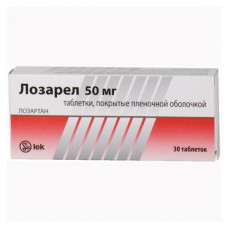Expiration date: 05/2025
The composition and form of issue:
Tablets, film-coated 1 tablet contains active substance:
losartan potassium 50 mg
excipients: microcrystalline lactose monohydrate starch pregelatinized silicon dioxide colloidal anhydrous magnesium stearate
film cover: hyprolose of hypromellose macrogol 400 titanium dioxide (E171) talc
blistere in 10 PCs. in cardboard pack 3 blisters.
Description pharmaceutical form:
Tablets: round, biconvex, white or white with a yellowish sheen color, film-coated, scored on one side.
Feature:
Losartan is a specific antagonist of angiotensin II (type AT1) receptors.
Pharmacokinetics:
Suction
If ingestion losartan is well absorbed and undergoes metabolism at the first passage through the liver by carboxylation with the participation of isoenzyme 2C9 of cytochrome P450 with the formation of active metabolite. The systemic bioavailability of losartan is approximately 33%. Cmax of losartan and its active metabolite are reached in the serum after about 1 h and over 3-4 h after ingestion, respectively. Eating does not affect the bioavailability of losartan.
Distribution
More than 99% of losartan and its active metabolite associated with blood plasma proteins, mainly to albumin. Vd losartan is 34 l. Losartan barely penetrates the GEB.
Metabolism
Approximately 14% of losartan, administering to a patient or oral, is converted to the active metabolite.
Excretion
Losartan plasma clearance of is 600 ml/min, and the active metabolite is about 50 ml/min Renal clearance of losartan and its active metabolite is 74 and 26 ml/min, respectively. The ingestion of approximately 4% of the dose appears kidneys in an unmodified form, and about 6% is excreted by the kidneys in the form of active metabolite. Losartan and its active metabolite characteristic linear pharmacokinetics when administered in doses up to 200 mg. Once inside the plasma concentrations of losartan and its active metabolite decline polyexponentially with a finite T1/2 of losartan is about 2 hours and the active metabolite is about 6-9 hours before the drug in a dose of 100 mg/day neither losartan nor the active metabolite are not significantly koumouliruet in blood plasma.
Losartan and its metabolites are excreted through the intestines and kidneys.
Pharmacokinetics in special patient groups
In patients with alcoholic cirrhosis of the liver mild to moderate severity, the concentration of losartan was 5 times and active metabolite are 1.7 times higher than in healthy volunteers men.
When Cl creatinine 10 ml/min, the concentration of losartan in blood plasma does not differ from that in normal kidney function. Patients who require hemodialysis, the AUC approximately 2-fold higher than in patients with normal renal function.
Neither losartan nor its active metabolite is not removed from the body by hemodialysis.
Concentrations of losartan and its active metabolite in blood plasma in elderly men with hypertension does not differ significantly from values for these parameters in young men with arterial hypertension. Values of plasma concentrations of losartan in women with hypertension are 2 times higher than the corresponding values in men suffering from arterial hypertension. Concentrations of the active metabolite of men and women do not differ. This pharmacokinetic difference has no clinical significance.
Description pharmacological action:
Angiotensin II selectively binds to AT1-receptors in many tissues (smooth muscle tissue of blood vessels, adrenal glands, kidneys and heart) and causes vasoconstriction and release of aldosterone, proliferation of smooth muscle.
In vitro and in vivo have proved that losartan and its pharmacologically active metabolite block all physiologically important effects of angiotensin II, regardless of the source or route of its synthesis.
Reduces PR, blood concentration of aldosterone, HELL, pressure in the pulmonary circulation reduces afterload, has a diuretic effect. Prevents the development of myocardial hypertrophy, increases tolerance to physical load in patients with chronic heart failure (CHF). After a single oral antihypertensive effect (reduced SBP and DBP) reaches a maximum after 6 h, then for 24 h gradually decreases. The maximum hypotensive effect develops within 3-6 weeks after regular dosing. Not inhibits the enzyme and, therefore, prevents the destruction of bradykinin, so losartana not typical side effects indirectly associated with bradykinin (e.g. angioedema).
In patients with hypertension without concomitant diabetes mellitus with proteinuria (>2 g/day) of the drug significantly reduces proteinuria, the excretion of albumin and immunoglobulins G.
Stabilizes the urea level in blood plasma. No effect on autonomic reflexes and has no lasting impact on the level of norepinephrine in plasma.
At a dose of 150 mg 1 time per day does not affect the level of triglycerides, total cholesterol and HDL cholesterol in the serum of patients with arterial hypertension. In the same dose losartan does not affect the level of glucose in fasting blood.
Indications:
- hypertension
- CHF (with the ineffectiveness of treatment with ACE inhibitors)
- nephropathy in diabetes mellitus type 2 (reducing the risk of development of hypercreatininemia and proteinuria)
- reducing the risk of cardiovascular complications and mortality in patients with hypertension and left ventricular hypertrophy.
Contraindications:
- hypersensitivity to the drug
- pregnancy
- lactation
- the age of 18 years (efficacy and safety not established)
- lactose intolerance, galactosemia or malabsorption syndrome glucose/galactose.
With caution:
- hepatic and/or renal failure
- the decrease in BCC
- violation of water-electrolyte balance
- bilateral renal artery stenosis or stenosis of the artery to a solitary kidney.
Side effects:
Usually side effects are mild and transient, do not require discontinuation of treatment.
The incidence of side effects is characterized as follows: very often — >10% — >1, <10%, sometimes — >0.1 and <1% rare >0.01, then < 0.1% and very rare, including private messages <0,01%.
From the CCC: sometimes — ortostatical gipotenzia (dozozawisimaya), nosebleeds, palpitations, tachycardia, bradycardia, arrhythmia, angina, myocardial infarction, vasculitis.
From the digestive tract: often — nausea, diarrhea, dyspepsia, abdominal pain sometimes — anorexia, taste disturbance, dry mouth, toothache, vomiting, flatulence, gastritis, constipation, hepatitis, abnormal liver function.
With the skin: sometimes — dryness of the skin, erythema, bruising, photosensitivity, increased sweating, alopecia.
Allergic reactions: sometimes — urticaria, skin rash, itching, angioedema.
The blood and the hemopoietic system: sometimes — anemia, thrombocytopenia, eosinophilia, purpura Henoch-Schonlein purpura.
From the side of musculoskeletal system: often cramps, myalgia, back pain, chest, legs, sometimes arthralgia, arthritis, fibromyalgia rarely — rhabdomyolysis.
CNS and sensory organs: often — dizziness, asthenia, headache, fatigue, insomnia and sometimes anxiety, insomnia, drowsiness, memory disorders, peripheral neuropathy, paresthesia, hypoesthesia, tremor, ataxia, depression, syncope, tinnitus, blurred vision, conjunctivitis, migraine.
The respiratory system: often — nasal congestion, cough, infections of the upper respiratory tract, pharyngitis, dyspnea, bronchitis, swelling of the nasal mucosa.
With the genitourinary system: sometimes — urgent need to urinate, urinary tract infections, impaired renal function, decreased libido, impotence.
The laboratory parameters: often — hyperkalemia (potassium level in the blood plasma of more than 5.5 mmol/l) sometimes — increase of level of urea and residual nitrogen or creatinine in serum very rare — moderate increase in liver transaminases AST, ALT, hyperbilirubinemia.
Other: gout.


